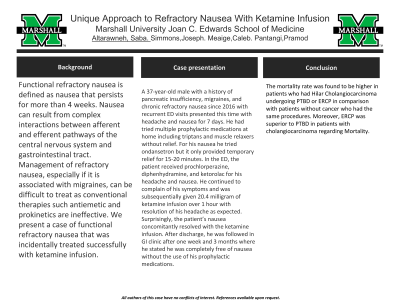Back


Poster Session B - Monday Morning
Category: Stomach
B0733 - Unique Approach to Refractory Nausea With Ketamine Infusion
Monday, October 24, 2022
10:00 AM – 12:00 PM ET
Location: Crown Ballroom

Has Audio

Saba Altarawneh, MD
Marshall University Joan C. Edwards School of Medicine
Huntington, WV
Presenting Author(s)
Award: Presidential Poster Award
Saba Altarawneh, MD1, Joseph Simmons, MD1, Caleb Meaige, 2, Pramod Pantangi, MD1
1Marshall University Joan C. Edwards School of Medicine, Huntington, WV; 2Marshall University, Huntington, WV
Introduction: Functional refractory nausea is defined as nausea that persists for more than 4 weeks. Nausea can result from complex interactions between afferent and efferent pathways of the central nervous system and gastrointestinal tract. Management of refractory nausea, especially if it is associated with migraines, can be difficult to treat as conventional therapies such antiemetic and prokinetics are ineffective. We present a case of functional refractory nausea that was incidentally treated successfully with ketamine infusion.
Case Description/Methods: A 37-year-old male with a history of pancreatic insufficiency, migraines, and chronic refractory nausea since 2016 with recurrent ED visits presented this time with headache and nausea for 7 days. He had tried multiple prophylactic medications at home including triptans and muscle relaxers without relief. For his nausea he tried ondansetron but it only provided temporary relief for 15-20 minutes. In the ED, the patient received prochlorperazine, diphenhydramine, and ketorolac for his headache and nausea. He continued to complain of his symptoms and was subsequentially given 20.4 milligram of ketamine infusion over 1 hour with resolution of his headache as expected. Surprisingly, the patient’s nausea concomitantly resolved with the ketamine infusion. After discharge, he was followed in GI clinic after one week and 3 months where he stated he was completely free of nausea without the use of his prophylactic medications.
Discussion: Functional refractory nausea has been associated with decreased quality of life for patients. This presents as an economic burden in terms of health care costs and resources with recurrent admissions and ED visits. Conventional treatments for nausea include the use of antiemetics and prokinetics to name a few. The use of ketamine infusion has only been reported in one other case study for abortive and prophylactic therapy for nausea. Ketamine is a noncompetitive antagonist to N-methyl-d-aspartate receptor. The mechanism by which it helps with refractory nausea is still unclear but it is believed to be related to reduction of neural transmissions by ketamine. Ketamine is a generic medication that is cost effective. Side effects of ketamine are dose dependent and include cystitis and liver toxicity, which is unlikely with the doses given for nausea treatment. This case represents incidental resolution of nausea with ketamine administration and more studies are required for its role in abortive and prophylactic therapy.

Disclosures:
Saba Altarawneh, MD1, Joseph Simmons, MD1, Caleb Meaige, 2, Pramod Pantangi, MD1. B0733 - Unique Approach to Refractory Nausea With Ketamine Infusion, ACG 2022 Annual Scientific Meeting Abstracts. Charlotte, NC: American College of Gastroenterology.
Saba Altarawneh, MD1, Joseph Simmons, MD1, Caleb Meaige, 2, Pramod Pantangi, MD1
1Marshall University Joan C. Edwards School of Medicine, Huntington, WV; 2Marshall University, Huntington, WV
Introduction: Functional refractory nausea is defined as nausea that persists for more than 4 weeks. Nausea can result from complex interactions between afferent and efferent pathways of the central nervous system and gastrointestinal tract. Management of refractory nausea, especially if it is associated with migraines, can be difficult to treat as conventional therapies such antiemetic and prokinetics are ineffective. We present a case of functional refractory nausea that was incidentally treated successfully with ketamine infusion.
Case Description/Methods: A 37-year-old male with a history of pancreatic insufficiency, migraines, and chronic refractory nausea since 2016 with recurrent ED visits presented this time with headache and nausea for 7 days. He had tried multiple prophylactic medications at home including triptans and muscle relaxers without relief. For his nausea he tried ondansetron but it only provided temporary relief for 15-20 minutes. In the ED, the patient received prochlorperazine, diphenhydramine, and ketorolac for his headache and nausea. He continued to complain of his symptoms and was subsequentially given 20.4 milligram of ketamine infusion over 1 hour with resolution of his headache as expected. Surprisingly, the patient’s nausea concomitantly resolved with the ketamine infusion. After discharge, he was followed in GI clinic after one week and 3 months where he stated he was completely free of nausea without the use of his prophylactic medications.
Discussion: Functional refractory nausea has been associated with decreased quality of life for patients. This presents as an economic burden in terms of health care costs and resources with recurrent admissions and ED visits. Conventional treatments for nausea include the use of antiemetics and prokinetics to name a few. The use of ketamine infusion has only been reported in one other case study for abortive and prophylactic therapy for nausea. Ketamine is a noncompetitive antagonist to N-methyl-d-aspartate receptor. The mechanism by which it helps with refractory nausea is still unclear but it is believed to be related to reduction of neural transmissions by ketamine. Ketamine is a generic medication that is cost effective. Side effects of ketamine are dose dependent and include cystitis and liver toxicity, which is unlikely with the doses given for nausea treatment. This case represents incidental resolution of nausea with ketamine administration and more studies are required for its role in abortive and prophylactic therapy.
Disclosures:
Saba Altarawneh indicated no relevant financial relationships.
Joseph Simmons indicated no relevant financial relationships.
Caleb Meaige indicated no relevant financial relationships.
Pramod Pantangi indicated no relevant financial relationships.
Saba Altarawneh, MD1, Joseph Simmons, MD1, Caleb Meaige, 2, Pramod Pantangi, MD1. B0733 - Unique Approach to Refractory Nausea With Ketamine Infusion, ACG 2022 Annual Scientific Meeting Abstracts. Charlotte, NC: American College of Gastroenterology.


